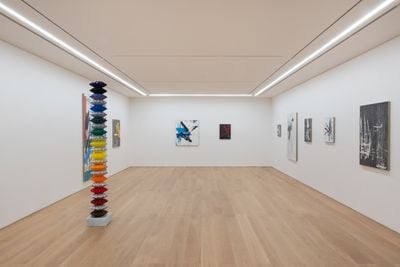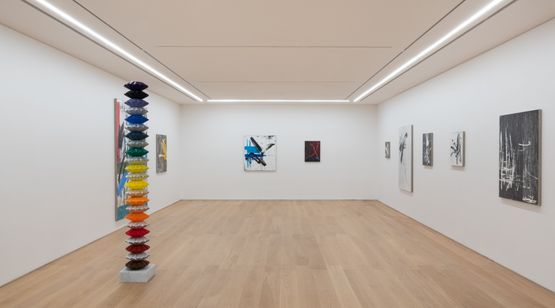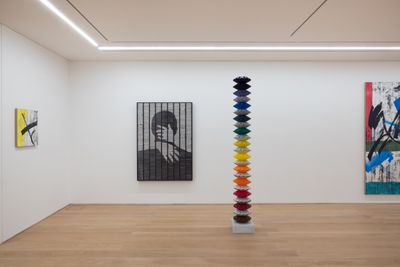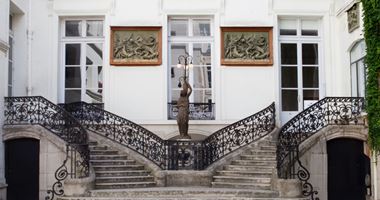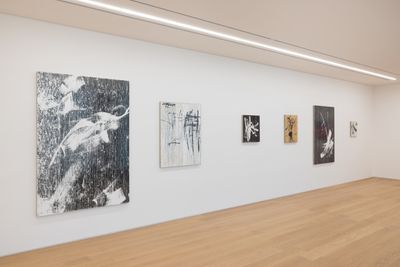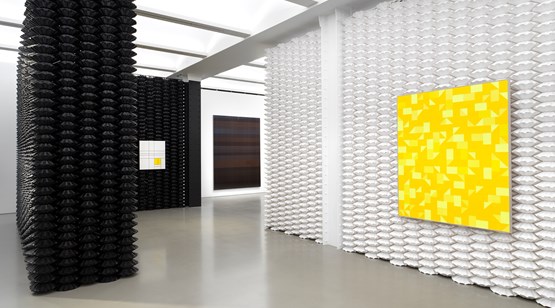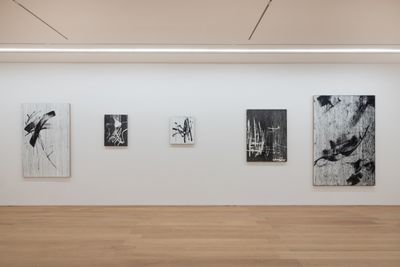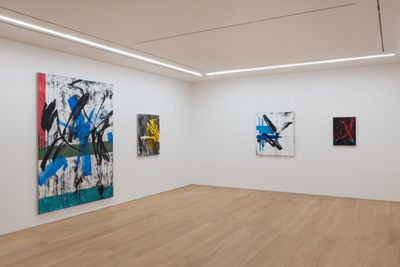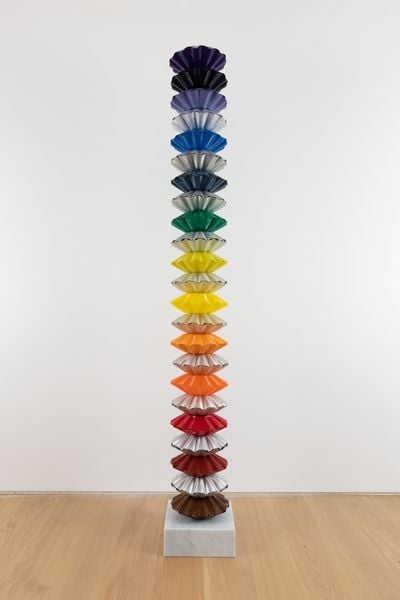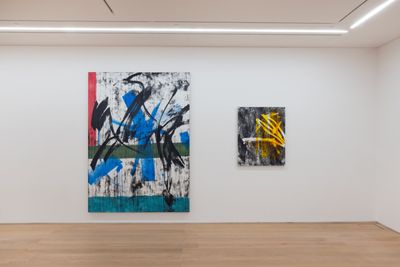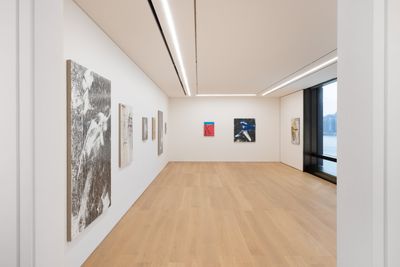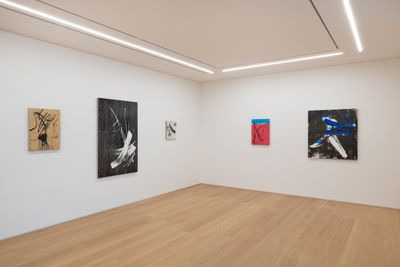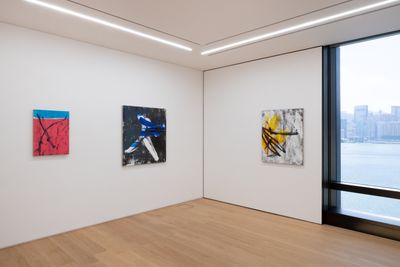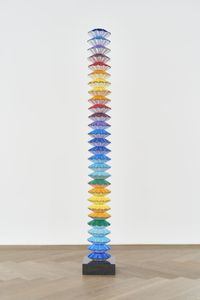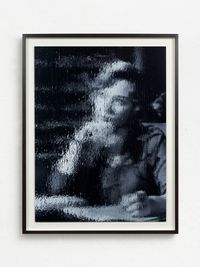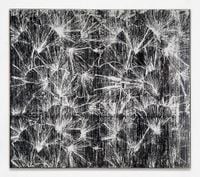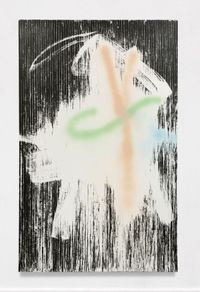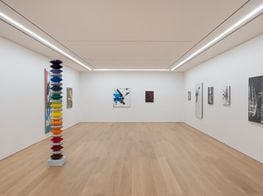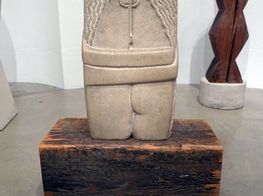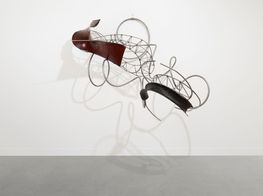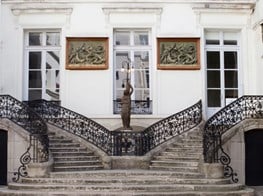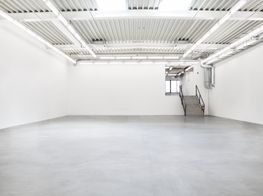Gregor Hildebrandt Memorialises Sonic Culture
Perrotin | Sponsored Content
Gregor Hildebrandt. Photo: Roman März.

Gregor Hildebrandt. Photo: Roman März.
Since the late 1990s, Gregor Hildebrandt has worked well-loved songs and biographical elements—from childhood memories to everyday encounters—into minimalist paintings, installations, and sculptures.
The immateriality of music has been a constant concern for the artist. As he has explained in Le Mile, 'You can't get a hold of a song, let alone see it. The idea, or the knowledge, that these magnetic tapes are full of music, or images, is what I find fascinating.'
Throughout his practice, vinyl and cassette tapes are rendered into sculptures and images as a means of combatting this immateriality. In 2004, the artist came across bowl-shaped records, repurposed as snack bowls, that he began assembling into Brancusi-esque columns and entire walls made up of the pillars—a pursuit he explains was 'motivated by the idea of drinking music' in reference to the bowl shape of the found vinyl.
Hildebrandt's 'rip-off' paintings are perhaps most emblematic of his homage to sonic culture, whereby audio and video tape is incorporated into dual canvases. Beginning with one canvas, the artist applies self-adhesive tape in vertical strips across the surface before painting patterns with translucent fixative. Audio and video tape strips are then applied, their magnetic coating sticking to the unfixed adhesive sections. To create a 'negative' painting of the first, the remaining tape is applied to a second canvas.
For Behind My Back, In Front of My Eyes, his solo exhibition in Hong Kong at Perrotin (25 September–20 November 2021), one such rip-off painting takes centre stage. Described as possessing a yin and yang dualism, the diptych-structured White flower pointing up (Alphaville) (2021) portrays a flower on each side within a diamond, with surfaces alternating from black to white.
In this instance, the tape used was that of the audio cassette for 'Big in Japan' by Alphaville, while the motif itself was pulled from a napkin Hildebrandt found in a restaurant while on holiday in Hakone in Japan before the pandemic.
Hildebrandt's embedding of personal encounters and experiences invites nostalgia, but any hint of sentimentality is concealed within cool and sleek aesthetics. The work thus behaves as mise en abyme, as seen in Die Hände auf dem Rücken (2021), in which the poster from Woody Allen's 2010 comedy-drama You Will Meet a Tall Dark Stranger is built up from the labelled edges of cassette tapes that the artist sourced from eBay, which form the black and white portions of the image of two figures embracing.
Hildebrandt reveals that in Allen's film, Antonio Banderas plays a gallerist in London, and the paintings on view in the gallery in the movie are in fact by the artist's professor from the Johannes Gutenberg University in Mainz, where he graduated in 1999.
It was during his studies, which continued at the University of the Arts in Berlin that same year, that the artist began thinking about how to incorporate audio into his practice. In the late 1990s, the artist recorded the song 'Falschgeld' by German experimental music group Einstürzende Neubauten, before cutting the magnetic tape out and sticking it into his sketchbook, igniting an impulse to transform music into material form.
Throughout the early 2000s, the artist developed his signature canvases covered with magnetic tape, gradually expanding his sculptures and installations to take on architectural dimensions. For Hirnholzparkett (2015), recently shown at G2 Kunsthalle in Leipzig (16 October 2020–17 January 2021), the artist wound up 35,000 audiocassette tapes into record-sized reels, before casting them into epoxy resin and layered them across the floor.
After two years of social distancing, the artist's works at Perrotin act as memorials to chance encounters, but also audio-visual culture, which, more than ever, has been the source of joy and solace throughout the pandemic. In this conversation, Hildebrandt discusses his approach to memorialising music.
TMYour exhibition at Perrotin in 2018 in New York was formed as a 'total environment', and I understand that your exhibition in Hong Kong will be slightly different, with a focus on the rip-off paintings. How do you use space to define the experience of each exhibition?
GHThe works are always placed together in a special way, using elements like whiteboards or wallpaper. In my previous exhibitions, I have used wallpaper that was typical in Germany in the 1960s—wallpaper that I grew up with. These elements have a mood-bearing influence on viewers without them being aware of it.
Sometimes the exhibitions don't involve a special environment, so that I can visualise long-term changes in the works. In Hong Kong, I wanted to leave the paintings on the wall. The whole show departs from the symmetrical painting White flower pointing up (Alphaville).
TMWhat is the importance of symmetry in your practice?
GHSymmetry provides a foothold. It is also predetermined by my rip-off process, because the formats contain the same sizes. At the same time, I consciously try to circumvent it somewhat in exhibitions, thinking of various tricks to justify this to make it more exciting and balanced.
In my works, the challenge is to include both—to have a song inside the painting, which is also like listening to a song while looking at a landscape.
TMThe rip-off painting White flower pointing up (Alphaville) contains the audiotape 'Big in Japan'. What was the decision behind referencing that song in particular?
GHI found this image on a napkin in Hakone in the winter of 2019, before the pandemic. I saw it and immediately felt it would be perfect for a rip-off painting. 'Big in Japan' was an emotional association, because I was in Japan at the time, and it is a typical German association to make.
Regarding the personal elements of the works, one of my students once said in an interview, 'art is my home'. I like that phrase so much, and always think about it. For me, art is my home, because wherever I am, I find inspiration.
TMWould you describe your works as memorials to songs that you love and have established personal connections with?
GHYes. You have to decide for yourself what really touches you, or what you enjoy. It can be painting or a song. In my works, the challenge is to include both—to have a song inside the painting, which is also like listening to a song while looking at a landscape.
TMAre there any songs in particular that have really informed your practice and how it has evolved?
GHYes. The rip-off paintings came about through a song by Einstürzende Neubauten. That was the initial spark. In my studies, too, I oriented my ideals not only towards artists, but also towards bands. I didn't want to make pictures like Cy Twombly, but to paint pictures like The Cure or Sonic Youth.
TMColour has also appeared in your recent vinyl sculptures that reference paintings by Frank Stella. I understand that this artist was one of your favourites as a child. How does your studio act as a memory bank? Do you have an archive of influences?
GHTo a large extent, I already carry the associations of various artists around with me in my memory, which then trigger impulses. I also have a library, and I use the internet more and more.
TMI understand you run a record label, too. Does the music of the artists you represent ever inform your own work?
GHYes, it does. I listen to their music all the time. When I really like a song, I listen to it again and again—I've done that since I was a child.
I share the label with my girlfriend, and the bands are mostly from Munich and Berlin. Among them are two student bands from my class. I wish to make their music accessible to a wider audience.
TMHow did you decide to become an artist? Had you ever considered following a path purely focused on music instead?
GHThe musical path never came up; it was never planned. The decision to become an artist came up according to my possibilities. Back in the nineties, you could study acting, music, and art without a high school diploma. Since I didn't have the opportunities for the first two subjects, studying art was my only option.
TMI am interested in your use of minimalist aesthetics, whereby cool, hard forms are used to explore transient subject matters such as music and its expressions of emotion and different aspects of life. Could you tell me a bit more about this approach?
GHThat came about naturally, in that I put the song on the cassette tape. The pictures became black because the cassette tape is black. But of course I also liked it.
For me, art is my home, because wherever I am, I find inspiration.
I established strong rules, like not using colour, or only being able to use the colour from the tape, or to only use colour from the starting or end lines of the tape. Now, quite recently, I have allowed myself a new use of colour, in relation to the sgraffito pictures that I did in kindergarten.
In sgraffito pictures, crayon is applied in different colours before it is covered in black and scraped off with a knife, so that the shiny background stands out. For the colour paintings in this show, I used black tape to mimic wax crayon, which I used in kindergarten. Using a new technique allows me to connect my current age to my early years.
TMArtworks by Friedemann Hahn, who was your professor at university, are present in the Woody Allen movie that the new cassette shelf on view in Perrotin is based on. What influence did Hahn have on your practice? Who were your key influences at university?
GHI first studied under Friedemann Hahn in Mainz in a figurative class, where I had to assert myself and my approaches. In 1999, I came to Berlin to work with Professor Dieter Hacker. By then, my approach had already established itself, so I was able to push my position further.
TMI am interested in your classification of your tape works as paintings, though they do not conform to the medium. Is this classification important to you?
GHNo. From the beginning, I always called them collages, though they do involve brushes and canvases. They also use colour, but not in the traditional sense, in terms of oil; rather, the black pigment is present as a result of the audio and VHS tape. I'm not a typical painter. It's more a sculptural, conceptual process.
TMI came across a quote by you in the Brooklyn Rail, relating to the rules that artists create for themselves, with you admitting that you 'greatly respect authority, and have marked out a narrow space for freedom within [your] work. But within that confined space, [you] move quite freely.' Do the same set of rules inform all of your bodies of work? Do these rules extend from your studio practice to setting up an exhibition?
GHThe challenge is having these strong rules and being able to move beyond them without hurting the rules you have established. Otherwise, you have to find another reason to do things or leave the rules behind you. You can't do things just because you want to, you have to find a bridge.
TMWhen you have a new idea, do you tend to create a large series of works in response to that idea? What does a typical day in the studio look like?
GHFirst, it becomes a picture. Then I think about how to improve it. Then there is the second picture. Then it occurs that I could do something else differently, and so on. The incentive is to make the best possible picture. That's where the series comes from.
The best thing for me is to walk from my flat in Mitte to my studio in Wedding, have a coffee on the way, eat a croissant, and make my phone calls on the way. That takes about 45 minutes. Then I arrive at the studio at around twelve, have another cappuccino, and then the studio work slowly begins.—[O]



